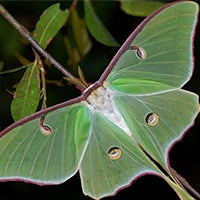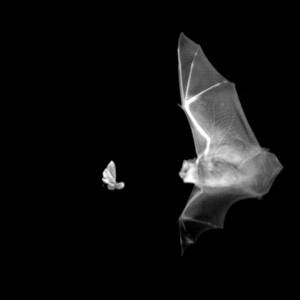Past research by Boise State University and University of Florida scientists has shown that some silk moths in the family Saturniidae have a built-in bat decoy: hindwings with long, elaborate “tails” that deflect sonar, creating a misleading target. As bats swoop in for the kill, they often strike these expendable tails and not the moth’s vital body core.
Now, a new study by the team, published in Science Advances and featured in National Geographic, illuminates the bat-driven evolution of these decoys across the silk moth family tree and tests four hindwing shapes in real-time dogfights between bats and moths. The verdict? The larger the hindwings and longer the tails, the better the moths’ chances of escaping bats on the hunt.
“Once we knew that the tails of silk moths deflect echoes away from their body, we were interested in whether there were optimal anti-predator shapes,” said study co-author Akito Kawahara, associate curator at the Florida Museum of Natural History’s McGuire Center for Lepidoptera and Biodiversity at UF. “One of the first things we did was go into the collections and look at specimens. There was a ton of variation in hindwing length, shape, color and twisting. We wanted to analyze these characteristics in an evolutionary framework to see what was happening.”
Kawahara and his postdoctoral researcher Chris Hamilton, one of the study’s co-lead authors, quantified hindwing shape in silk moths, mapping the evolution of this trait across a detailed family tree. Instead of gradual increases in hindwing length and complexity, they noted abrupt shifts in shape, showing that certain wing shapes might be significantly more effective at deflecting bats than others. Four classes of shapes were linked with moths’ ability to escape bat attack: two types of extra-long tails, short tails and long lobes.
These shapes have appeared multiple times in silk moths globally, and nearly identical shapes often showed up in moths that were not close relatives.

“We see moths moving toward peaks of optimal shapes with unrelated moths evolving in similar ways,” Kawahara said. “This speaks to bats’ selective pressure on their prey.”
After identifying these major hindwing shapes, the team test-drove them against the judges best qualified to rate their efficacy: real bats.
After modifying the hindwings of three types of silk moths – polyphemus moths, luna moths and African moon moths – to match these shapes, researchers in study co-author Jesse Barber’s lab at Boise State pit them against big brown bats in a flight room with high-speed cameras and ultrasonic microphones.
Silk moths might be delicately built, but stacked against bats, they are hardly sitting ducks. With wingspans of more than 5 inches, their large size puts pressure on their predators to aim well. Bats and moths also have impressive flight capabilities, said Juliette Rubin, the study’s lead author.
“Bats are incredibly acrobatic and very skilled hunters, but moths are also powerful flyers and have an incredible turn radius,” said Rubin, who completed the research as a Boise State master’s student. “They seem to be pretty well-matched adversaries.”
Unaltered polyphemus moths escaped bats only 27 percent of the time in the flight room. But enlarging their lobed hindwings to match the size of two different tribes of silk moths upped their escape rate to 56 percent.
African moon moths, which have long tails, performed much better with their tails than without. Unaltered moon moths evaded bats 73 percent of the time, but this dropped to 45 percent with shorter tails and 34 percent with none. Luna moths, another tailed species, followed a similar trend.
Bats only eat a moth’s body, not its wings, and they need to attack its core to be certain of success. Long tails are likely creating the illusion of multiple targets, confusing bats and tricking them into striking at tails, Rubin said. Because moth flight depends on their forewings, a rear attack often enables them to skirt away safely, even if they lose part of their hindwings in the process.

Rubin said a bat’s typical attack behavior can include closing its wings around a moth or extending a wing to scoop a moth into its mouth. But when trying to strike moths with longer tails, “they’d reach out for the tail ends, and the moths would escape almost every time.”
The power of these sensory illusions as evolutionary drivers is often underappreciated, she said.
“Prey might evolve in ways that exploit weaknesses in the armor of their predators’ perception,” Rubin said. “We think this is happening across different systems, not just in moths.”
Could bats figure out a way to bypass silk moths’ defense tactic? Rubin is skeptical. Even after facing the same types of hindwing shapes for months, bats did not improve their ability to discern a juicy moth body from a useless decoy.
“If these tail traits are altering or manipulating the information bats are receiving as they try to assess where the moth is and where to attack, that could be a hard strategy for bats to get around,” she said.
Other co-authors include Chris McClure from Boise State and the Peregrine Fund and Brad Chadwell from the Idaho College of Osteopathic Medicine.
The National Science Foundation, the National Geographic Society and Sigma Xi provided funding for the research, with postdoctoral support from the Florida Museum and graduate research support from Boise State University.